Bootstrapping in your organization and community Douglas C. Engelbart. 1.* - unedited transcript - Welcome back to session nine of the "Unfinished Revolution". Every time I have to say, this is not my "Unfinished Revolution". It is society's "Unfinished Revolution". So, the sessions name is bootstrapping in your organization and community. During the course of the previous eight sessions, we have gone through the cycle of the different parts of the conceptual framework, several times and talked about bootstrapping. I am going to dip into a little bit more, come up for air, and we have some very interesting speakers today. Let's get going. The idea for the terminology of bootstrapping emerged, for me, way back.
So I though it would be interesting to go back and show you the frame which
that introduced. So there was a report eleven years after I started
off on this great jaunt.
I had had some support from an air force office of scientific research
to actually do a study for building a conceptual framework. If I had known
at the time what the word paradigm meant, it hadn't been published
yet, I would have said paradigms. That's a thick report; part of it was
published a year and a half later as a chapter in a book. A few years ago,
this was put on the web. It was done in Germany as the first link.
There are some errors in there on translation. That was transferred
over as part of Stanford's history site. That doesn't have any diagrams.
So, I used the German ones still. A really admire the graduate student
who went out and found that and managed to do a nice job converting.
So we are going to get some views on that. So, I want to say thank you Dr. Fredwall. It was nice for him to do that and communicate with us and say it was accessible.
So here's a part of that report. The thing that I am trying to do is develop the concept of the bootstrapping as it emerged in there, just to get it clearer. So I said if I start a research activity and labeled it A-1. I said I would be depending upon the information on the existing disciplines that are out there in the world and that would provide me the solid lines on information about psychology and whatever was going on in the world. Also, the outside world would be providing me with tools and techniques, which I could use to do the research. You know computer programming and the like. Both of those things were important. The background knowledge I was going to use and digest, but essentially the things that were going to augment me. So I had the dotted line for that, in this report we start expanding on that picture. Saying when I got going I would have that product and the product of our research would be how do you augment yourself through computers.
Look, we would feed that output back which would be knowledge and etc..but it would come back in as capabilities and technologies I could use to increase our laboratory's efficiency. That was the very first thing I called bootstrapping just really feedback that if your output is something that can improve your capability, boy you plow it back and it is really good. The thinking about that really matured during the writing of this contract until there was a whole framework.

I am starting at the bottom of it cause I couldn't get it all on the screen. So here is the D1 and the A2 that we were talking about here. We will unfold this as it goes just to show you something about an infrastructure in which bootstrapping had quite a few levels of activity.
The total program, that is the title of the report suggested relationship among the major activities involved in achieving a state of objective, which is essentially boosting human power in the A3 and E1 boxes. That is very noble.
The first box D-1 down there is other disciplines relevant to basic augmentation research. Psychology, Linguistics, A-I, Computer Science, and automated instructions. Then that feeds in directly with a dotted line and a solid line back into the actual basic research that we were going to establish.
Then this was the basic augmentation research empirically and total system oriented. To boost the capabilities on and up the line including itself. By the late 60's, we were actually doing it.
Then the next one was a special application research specifically to given real world problems solving tasks. Among the first of these are A4 and U1. So, we explicitly oriented that for program support, for design. Then by 1974 for field support we had people out there selling services. We are actually moving up the line here. You have to put it to work in real environments in order to learn that. You notice by now that you are starting to see more dotted lines. That is where the intriguing part comes.
So then this problem here we never really got going we were always hoping. That to get an activity going you can not instate critical problems and educate awareness among those who can initiate solutions. This is why I was so tickled to have Gerry Glen come and tell us about the United Nations University Millennium Project to study what are the major big challenges to society. That is the kind of thing that we would really like to do and the next one would say that you would like to get product development going so that you can actually deliver those systems to wider utilization.
If they ended up in the commercial world actually doing that, the thing is by the time you got in the commercial world, the research that was supporting the bottom part kind of got lost. So that sort of vanished and now they are just floating off by the top. They learned a lot still in the commercial world. Then up here, find the F and you get this thing working and you'll be able to attack the real problems of society. That was a big goal.
That is what is in my mind when we talk about improvement infrastructure
and augmenting large scope parts of society. That is still there and the
nice feed back about dotted lines turning into solid lines, and solid
lines turning into dotted lines, the feedback, are all parts of how
the thing can bootstrap. Sometime I am looking forward to having some
people that I can dialogue with cold fellows, if you wish, like graduate
students or something that over the months we can start digging into
these things and we can bore down. There is more than I can hold
down and keep track of in my head.
So this bootstrapping idea is a strategic matter. It is how to get the
most improvement in your organizational capability for unit of expenditure,
expenditure in dollars, and people efforts. Looking at the scale
of things as we did early on, we said it is just a huge scale of
problems out there and a huge scale challenge out there to build something
on a scale out there that is going to effect out ability to cope
with it. In that feedback picture that I talked about there are many
loops and so that loop back gains in that organizational capability is
part of the strategic thing to think about. We haven't had a chance
to dig down into that very much, in our time with this, but it is
a big factor in all of the different little ways you can strategically
you can make choices that do that kind of feedback to help bootstrap.
The best bootstrapping is with loops that improve the improvement infrastructure.
We have been through that before. That is why the serious pursuit of the
boosted collective IQ would be such a dynamite investment for any
large organization or significant social institution. For any country
or the world, that just seems to fall into a huge amount of quality, positive
feedback to give you the bootstrapping. Then I ran across things
called grand challenges. People would variously list them out there
in the world. As far as I am concerned, the fifteen that Gerry Glenn's
group has isolated is a good set of grand challenges. They are sitting
there for the world to take on. How about noting that this augmenting
our collective capability to deal with complex problems could be
classed as a grand challenge.
That enhances our ability to pursue any and all of the other grand challenges.
In a sense that should be the grand challenge of all. It takes a little
more than to write that down or say it around the world a few times,
but it really is. When is the world going to take after it explicitly?
This is different from saying we are working on e-commerce, or knowledge
management in our environments. It is sort of explicitly how would
you go about strategically to say mankind you are going to...it is
sort of like the invention of rioting a long time ago, it is a new sort
of way in which you can externalize your concepts and deal with them.
So why not get going, I saved Ted Nelson for the last. When he gets
up he is going to tell you it's all wrong let's get going.
More appealing to say that challenge one of boosting society's collective
IQ, by using that gain to do number two, boost society's improvement infrastructure.
You get a second benefit out of that the grand challenge of improvement
infrastructure. If you can boost two and you apply that to one, you
have better ability to go do your boosted collective IQ because your improvement
infrastructure is better. If you do that better then that can feed back
into your improvement infrastructure that you can improve things
better. Which includes improving the collective IQ. The dynamics
like that are there to go after. That's been the plan. How could you beat
that multiply compounding value proposition? That is sitting there
as a value proposition, but how do you turn that into a value proposition
that you can talk inside of bigger organizations that really have to
be involved in this before it is really going to work.
I found some interesting slides that we used in classes in 1991-92 in seminars. They said it so well still, so I am going to pour some of them at you now. It is going to be likely that many organizations are not going to be able to adapt quickly enough or appropriately enough to survive the complex and rapid environmental changes that we are just headed for. So, these are rapid environmental changes that will be continuing phenomena for many decades. The surviving organizations will have developed an especially energetic and intelligence internal process to plan and manage their evolution. This is needed a pragmatic global continuing strategy for investing in evolutionary improvement. That is the kind of bootstrap strategy purpose. Continuing evolutionary improvement. We come around to that, what we have to do is find an effective evolutionary environment and get it established. Look at the kind of things that impede that and see if you can readjust our social structures so we can get going on that kind of bootstrapping. Here is a curve I put in some years ago.
If you have some brand new capability enhancing augmentation system. You bring it in and it is going to cost you for time. It will probably drop your productivity and capability, etc..and then slowly work its way up until it does its thing. During all of that time, you are spending money and getting it installed and built up to get it going, so it is fairly expensive. What you have to do is trade off that expense for the gain in capability. Here is what has really been happening all the time in the computer world, purvey, and gooey and everything else so it is easy to learn and you get up there quickly.
We say hey, look there are things like that, you really need to find out what capability gains are possible, and then judge whether the expense of getting to that is worth the gain. Some kind of operatory thing that is fixed by people paradigm of how thing are going to work and particularly by the turn of automating your office work. Which would nail it there. This is the kind of thing I think Ted and I both have been doing for several years, just fuming and flapping out hands and saying there really are different things that can be tried. They are not the kind of ways that you are used to working, reading, talking, and interacting with people. Those all built up around the means we had for communicating and externalizing our symbols at the time. We take that as the natural human way because that is how we adapted to the technology and the means at the time. We are freed from that now so we can back up and learn some different things. That's just a very important thing. When in the world you are trying to tell someone something important
that they could be doing, if they don't see that there really is potential
like that. They shrug their shoulders and wonder why you are flapping
your hands and say that it is already taken care of it, the market is taking
care of it. It is very critically important that somehow we starting
being able to start demonstrate the new capabilities that are there
in an environment that is significant to people.
Now this is a term now they are already talking GroupWare. The web was not out there. The user organization community must become more proactive. This is something that I have said before. Unless the user organizations really start figuring out where they need to go and start actively assessing it, and making plans for boosting that. They are going to say that we are already buying the best from you know who. You say that there is more that they can do. They say what do you mean the marketplace is what takes care of that isn't it? The market place won't know how to take care of it unless the users, the consumers that are end user organizations, aren't really proactively looking ahead to say where do they want to go? Where can they go? They are not going to be doing that unless they invest in looking out ahead. This is the kind of problem. If they stay not investing in extending their site and understanding then they are going to be walking along like this. Some day some of them are going to start looking out there and making plans that are going to be different and the short sighted ones are going to be those who suffer for it. All we have to do is get some long term ones started. I think what I will do is, I have quite a train of some of these things that I would like to deliver to you but we can stop in-between and sort of introduce some of our speakers and let them have a discussion about their particular point of view. One point of view that is really interesting is majors and how you get quality out there and how you get people to move along with tools that have standards in them. I am going to introduce Allen Brown. He is president CEO of Open Group. He will tell you who that is. Driving toward interoperability Allen Brown, President and CEO, The Open Group Group discussion What I hope to do as we get a little dialogue here is at least two people here, and Jeff are involved in this kind of thing. What is the connection between the process he has been describing and the open way that the knowledge containers are going to show and carry our knowledge in new ways? They have to be open and interoperatable. I just had a dramatic experience in the parting with Donald Douglas is that the engineers pointed out to me how many suppliers were involved in close interaction with the actual two thousand people, and Donald Douglas who designed and manufactured the thing. There was six thousand companies involved, and they said a big air transport would be thirteen or more thousand. Those all have to interchange and do critical kinds of knowledge and design specks and actual product and testing materials. The kind of ways in which all of the hyper media in the future are going to be able to connect with that and help the dialogue go on are just dramatic. That just convinced me that there needed to be something like that. Anything from our seated panel? Audience: It seems to me that there are a number of different approaches in trying to improve various parts of organizational IQs and Allan had touched upon one. In terms of his consortion model, he is looking at the suppliers on the one hand and the customers on the other hand. In our case is the software productivity model. Our funders or the suppliers, if you will, are really the customers. So, we really have that loop if you will, in terms of the improvement process. The other part that really strikes me is if you want to relate it to the models that have been discussed in this group, my understanding is that Allan touched upon a group of suppliers that typically fall into the space of dual suppliers or infrastructure suppliers. In order to improve the organizational IQ we need other parts or aspects to be improved, such as processes and frameworks. There are various organizations that are trying to wrestle with these various aspects, and at some point they need to come together. Audience: I spent a large part of my career in consumer electronics. You mentioned the example of Beta-Max. I would say that the industry really learned from that. Generally now they do form standards because they do want that big market. I would suggest MPG 2, MPG 4. There are a lot of examples of that where the industry got together and established an industry standard. They want a world standard now. I would just suggest as far as the Web, and the kinds of market that are available worldwide are going to force people into this mode than the other. Brown: I agree with that. I think that it is inevitable that people will move into that mode. Where we are in the software side. The platform side. It is taking longer to get there because there are a lot of people that are looking to trying to establish a differentiated position constantly. Audience: An example of the so called multi-media, where we have Macromedia Director, we have Flash, we have Power Point, we have QuickTime, and we have the World Wide Web. The interoperatability level is very slight, at it will probably remain so. Things can be exported; things can be transformed, like you create little women the video game. It is no longer very much what you started with. I think with mission critical applications and area where there is a well-defined thing that you should do, like a rocket reaching the moon; it is possible to agree on standards. I think the prospect will be much bleaker in the media area. Unbelievable. I just got a message on my computer, saying that there is some kind of blip I should reboot. Brown: While you are doing that, I just want to mention that a topic that the Department of Defense brought up at our conference in January. They are trying to implement object technology. There is an existing standard for object technology. Nothing conforms to it. Audience: Will you tell us what that is? Brown: No. The standard is 2.1 standard. Audience: Which is one of many. Brown: We are trying to work with the standards body that is responsible for that. To try and help the industry get to the point where orbs from different manufactures really interoperate and enable the DOD to what it is they want to do. The issue for them is that if we cannot get to interoperability. They will get to have two choices. One is buy nothing and go some place else. The other is to single source. For any large organization, single sourcing....buying all of your pencils from one place is a big deal...but buying mission critical application infrastructure is a significant step. The same is true of security and certificates of security. The same problem, lack of interoperatability. What do we do? Do we go some place else and try and figure out a different way of doing it? Do we single source, or do we work with the suppliers to understand how they and everyone in the market can benefit, and we can get interoperatable products delivered and everything will grow and more innovation will follow. Audience: The League of Nations was an endeavor to settle international issues peacefully, and trying to settle standards peacefully may run into the same historical eventuality. Audience: The only thing I have to say about that is that I experienced several standards in the area of media that have been successful. So, I have examples that it is possible to do this. To do it at a very high level of achievement and come up with an excellent standard. I think that there are models out there like the MPG 3 group and others that you can build on when the market is big enough, and when the player in the market have decided after hurting themselves badly enough several times after going after large markets, that it is a better root. Audience: As with MPG, sometimes the players' decisions may hurt them as in MP3. I should apologize to everybody, I invited Ted. Ted: You knew what you were getting in to. I have known him for many years and we have agreed that we will stay friends anyway. Audience: I have a colleague that did a contract for a military general at one of the services. They told them go find out why this years version of this did not work with last years. He started doing an order through the system. The programmers are doing a good job, the designers are doing a good job, until someone higher up in the organization took him aside and said that if we made it competitive to what we made last year we wouldn't be selling as many this year. Some of the answers have nothing to do with single sourcing. There is manipulation going on to preserve the market. I think that we will get on with that. There are several things about the standards. One of them is unless the user organizations get more pro-active; they are going to get tugged around. The other is that when we get into this thing of collective IQ, and things like that, where your exchanging knowledge and the vocabulary, dialogue that goes on between you, really gets to be essentially like what is the control of the evolution of our vocabulary and our dictionaries under control of somebody who got a paten on the word. You couldn't use it unless you got an ok with that. You say when we are getting into that domain, the drift of what has happened in the world into the language, thinking, and communicating, it is hard to believe that society in order to get smarter will put up with that. Audience: It seems to me that with the rate of change increasing now we need to stop looking at objects and specific insights and start creating a language of flows of processes. One where insight is a constant flow of discovery. That is part of the evolution that I really see need to be done. You have to evolve the environment so that the way in which we think and work with our heads can evolve effectively. We will open up something else by introducing Kurt Carlson who is the president and CEO of Stanford Research Institute. He is going to speak. What is the value proposition? Exponential teams, NICs, etc. Curtis Carlson, Ph.D., Physics, President and CEO, SRI International - Break - Welcome back to the second half. We have an interesting arrangement now that we have in New York on the telecommunication video telecom arrangement is Michael Hart. Sometimes you will see him on the screen. Sometimes he'll see me or different shots of you guys, and so we are assuming dialogue. Michael, can you hear me? Can you say something? Bootstrapping at CitiGroup Engelbart interviews Michael Harte and Rick Swanburg Value proposition that is what we are after. So, I respect whatever value proposition drove you to this expense of time and energy to tie to us. We appreciate it very much Michael and Rick. I'd like to get in touch with you in a couple of days to thank you and talk it over. Thanks to the crew back here to make that work. They had to scurry cause the idea only came up yesterday. I think with out my diving into any slides, I will turn it over. I will give you fair warning that what you are about to experience....my old friend Ted Nelson who we got aquatinted thirty three years ago. He was a very young man at the time, and it has been great. He is off there waving at the world, and sometimes we wave at each other. We can share a lot of experiences, of trying to wave at the world at not sure that we get anyone to wave at the world. He keeps going on, and so do I. He has got some really interesting things. One of the things that I would like to tell everybody, is when we try to get something going that is an evolutionary process, and an evolutionary hyper-document system that is open for evolution I think it would be extremely important to integrate the kinds of things that we would like to do with the kind of things that he talks about because something in the fusion of those things would be very important. He is a pretty good kid. One time he was going to make a movie. He needed somebody to play the role of his father. I don't know how he did it but he talked me into doing it. So take it away. Where our hyper-media really should go! Ted Nelson, Project Professor, Keio University, SFC Campus, Fujisawa, Japan Well can we cut and paste on them? Well I thank you.
---
Above space serves to put hyperlinked
targets at the top of the window
|

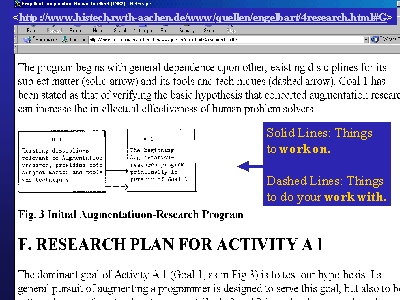 Fig. 1
Fig. 1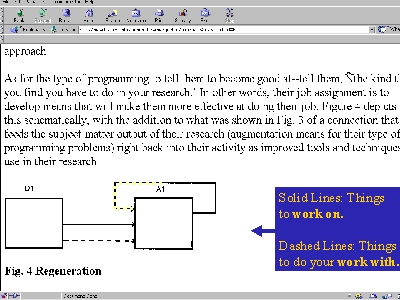 Fig. 2
Fig. 2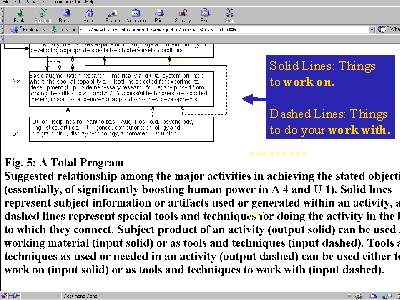 Fig. 3
Fig. 3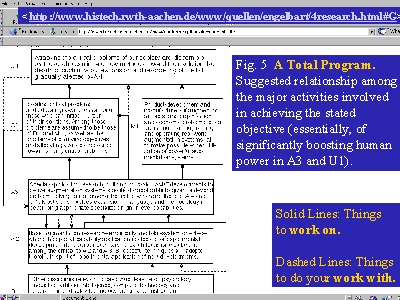 Fig. 4
Fig. 4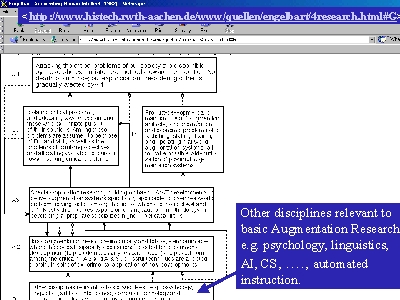 Fig. 5
Fig. 5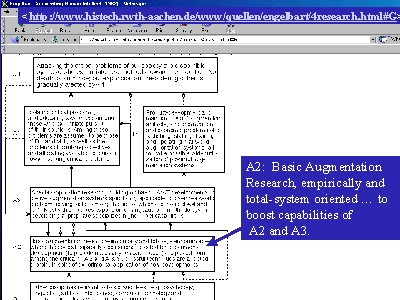 Fig. 6
Fig. 6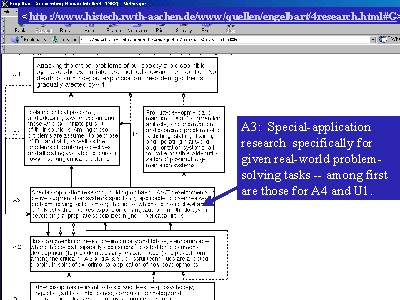 Fig. 7
Fig. 7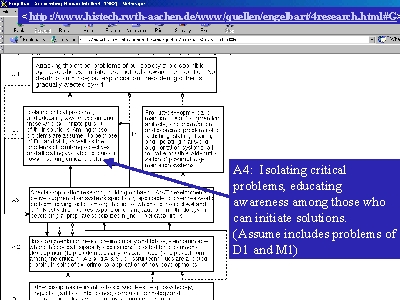 Fig. 8
Fig. 8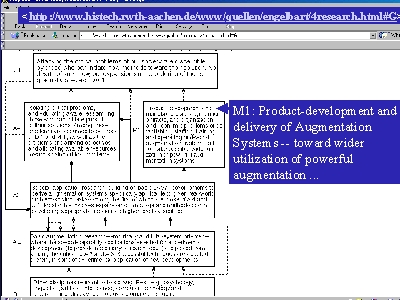 Fig. 9
Fig. 9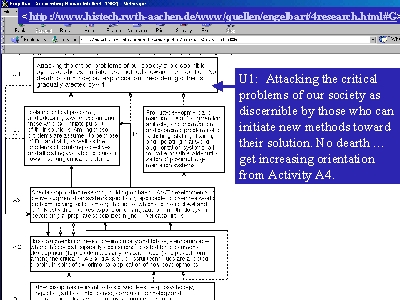 Fig. 10
Fig. 10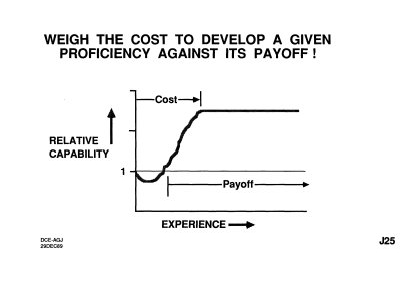 Fig. 11
Fig. 11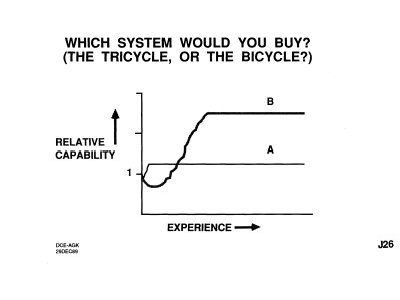 Fig. 12
Fig. 12